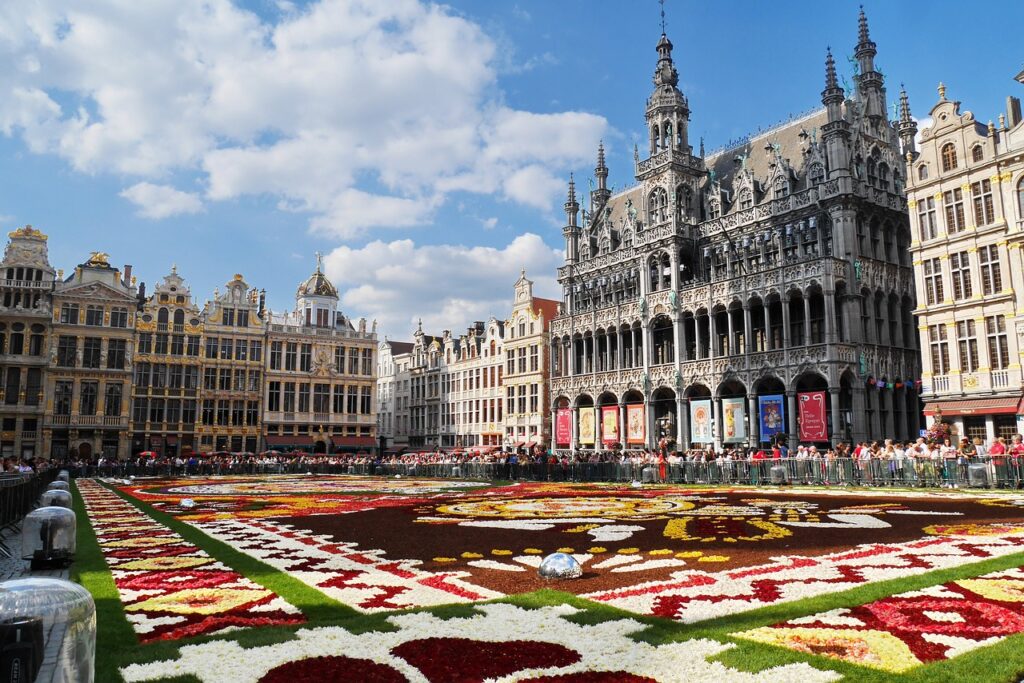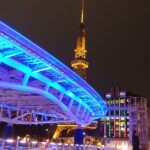In Brussels, using the public transportation system is a quick and inexpensive method to get around. A regional train system that connects to the rest of Belgium is part of the public transportation system, along with the metro, buses, and trams. The majority of the city center and its top attractions are covered by the four lines that make up the metro network. Additional coverage is provided by buses and trams, many of whose lines continue far into the night. With direct connections to locations like Antwerp and Bruges, the regional train network links Brussels to the rest of Belgium. There are single-trip tickets, day passes, and long-term passes available in Brussels, making public transit open to all of us.
Basic information about the Metro system in Brussels
In Brussels, Belgium, the metro offers a quick and affordable means to get about the city. It is run by the STIB/MIVB (Maatschappij voor Intercommunaal Vervoer te Brussel/Société des Transports Intercommunaux de Bruxelles). The system comprises two premetro lines, and four metro lines, each of which is distinguished by a unique color. These lines have a track length of 61.7 kilometers, 60 metro stations, and 11 premetro stations that together serve 63 stations. The premetro operates from 5 a.m. to 1 a.m., and the metro system is open from 5 a.m. to 12 a.m. The metro’s network of connected routes makes it easy for people to get around the city.
The lines of the Brussels subway system
Brussels has six metro lines that connect more than 80 stations. This makes it one of the best and most complete subway systems in all of Europe. Because there are so many lines and stations, you can get around the city quickly and easily.
Line 1 is the name of the first metro line in Brussels, which debuted in 1976. (North-South). With stops in the city center at Arts-Loi, Central, and Luxemburg, it travels from the northern suburbs of Laeken to the southern suburbs of Elsene and Jette. With an average of 70,000 passengers per day, this line has the highest volume of traffic among the metro lines. With stops at Rogier, Schuman, and Bourse in the city center, Line 2 (East-West) connects the western suburbs of Bockstael with the eastern suburbs of Ganshoren. It was first introduced in 1979. An average of 45,000 people utilize this line every day. Line 3 (Circle), a circular line with stops at Arts-Loi, Anspach, and Rogier in the city center, began service in 1988. It travels from Albert to Simonis. An average of 50,000 people utilize this line every day. Opening in 1993, Line 4 (North-East) connects Heysel’s eastern and northern suburbs, with stops at Rogier, Arts-Loi, and Bourse in the city center. An average of 40,000 people utilize this line every day. With stops at Arts-Loi, Bourse, and Rogier in the city center, Line 5 (South-West) connects the western suburbs of Bockstael with the southern suburbs of Elsene and debuted in 2009. An average of 30,000 people utilize this line every day. Line 6 (North-West) was introduced in 2009 and connects the western suburbs of Bockstael with the northern suburbs of Laeken, stopping at Arts-Loi, Schuman, and Rogier in the city center. An average of 25,000 people utilize this line every day.
Six metro lines connect more than 80 stations across Brussels, making the city’s underground system an effective and convenient method to move about the city. The extensive network of lines and stations in Brussels’ subway system ensures that getting where you’re going will be simple.
Map of Brussels Metro 2023 – Free Download in PDF

The free, PDF-formatted Map of Brussels Metro 2023 is useful for those who are considering visiting Brussels. The metro lines, stops, and significant sites are all listed on this map, along with all the other information required to organize a trip to the city. It also offers recommendations for the easiest paths. Anyone planning to explore Brussels should download this map because it not only saves time but also money.
Public transport tickets in Brussels – Best types for travelers & actual prices
In Brussels, public transportation is effective, dependable, and reasonably priced. You need to have a valid ticket in order to move about the city. There are many different ticket options, and the cost varies according to the route and time of departure. We give a thorough summary of the various ticket options, their costs, and a lot of specific information on this page.
The STIB/MIVB tickets are the most popular ticket kinds in Brussels. These tickets come in three different forms: single, 10-trip, and monthly passes. The price of a single ticket is €2.50; a 10-trip ticket is €16.50; and a monthly pass is €45. All modes of public transportation, including buses, trams, and the metro, accept these tickets. The Brussels City Card is another ticket option. For 1, 2, 3, or 5 days, this card offers unrestricted use of public transportation. The Brussels City Card costs €14.50 for a single day, €25.50 for two days, €37 for three days, and €45 for five days.
For specific events and occasions, there are more tickets available in addition to those listed above. The Night Network ticket, which is good for all public transportation after 8 PM, the Tourist Network ticket, which is good for all transit for a whole day, and the Airport ticket, which is good for all transit to and from the airport, are a few examples. Depending on the type of ticket, these prices change. Additionally, there are some discounts offered to certain demographics, like seniors and students. All tickets are 30% off for students, while single tickets for seniors are 50% off.
What is the best option for tourists?
Tourists who want to explore Brussels should consider the Brussels Card. This all-inclusive card offers free or reduced admission to a number of sites in addition to unlimited use of the city’s free public transportation system. Additionally, it provides discounts at a few restaurants and stores. The card can be purchased for 24, 48, or 72 hours. The STIB/MIVB Card is a smart choice if you want to use public transportation frequently. You can use this prepaid card to pay for bus, tram, and metro rides. You can purchase the card and top it off with funds as necessary. You can also receive discounts on specific tickets using the card.
The Mobib basic card is a fantastic option for people who just sometimes intend to use public transit. This is a single-use card that can be used for one trip or several trips within the same day. It is available for purchase at every metro stop and is good for 90 minutes following the initial use. The Hop On Hop Off bus is another excellent way to travel about Brussels. With an open-top bus, visitors can get off at any time to explore a variety of well-known attractions. A single ticket or a multi-day pass is available for less money.
In conclusion, Brussels offers a variety of ticket options, including single tickets and monthly passes. The price depends on the type and length of the excursion. Additionally, there are some special tickets for particular occasions and holidays as well as exclusive discounts for particular groups of people. The diversity of tickets available makes it simple to find one that satisfies your requirements and price range.
Summary of fares for public transport in Brussels
- STIB/MIVB tickets: single €2.50, 10-trip €16.50, monthly €45 (valid for all modes of public transport)
- Brussels City Card: 1-5 days, unrestricted use of public transport, €14.50-€45
- Special tickets: Night Network (after 8pm), Tourist Network (all day), Airport (to/from airport)
- Discounts: Students 30% off, Seniors 50% off
- Mobib Basic Card: single-use, 90 minutes following initial use
Timetables & Schedules of THE Brussels Metro system
The Brussels Metro system operates from 5:00 am to 12:30 am from Monday to Thursday, 5:00 am to 1:30 am on Fridays, 6:00 am to 1:30 am on Saturdays, and 8:00 am to 12:30 am on Sundays. During peak times, the metro system runs with a frequency of every 5 minutes, while during off-peak times, the frequency drops to every 10 minutes. It is important to note that the metro system may be suspended at certain times for maintenance or due to inclement weather, so it is advisable to check for any potential changes or delays before traveling.
What Are Other Options For Public Transportation In Brussels?
The Metro isn’t the only means of public transit in Brussels, but it’s a terrific way to move around the city. Commuters have a variety of additional options, both public and private. Here are some of the greatest alternatives to using the metro in Brussels.
Get quickly around the city with trams Over 20 routes make up Brussels’ large tram network, which covers the entire city. Trams are an excellent way to move rapidly through the city because they are frequently quicker than buses and trains. In general, trams run more often; during peak hours, one tram runs at least every ten minutes. Trams travel through the city’s core and along some of Brussels’ most well-known sites, making them an excellent way to sightsee the area. Tickets for trams can be purchased via ticket machines or the ticket office at the major tram stops. Trams have a fixed fare system.
Late night? Use buses!
With over 250 bus lines operating across Brussels, buses are an excellent method to move around the city. The buses are an excellent alternative for late-night travelers because many of them run into the night. Tickets for buses typically cost around €2.00, which makes them quite affordable. The city’s sights and attractions are easily accessible by bus, which makes stops at the Grand Place, Palais Royal, and other well-known locations. The several parks in Brussels, such as Parc de Bruxelles, Parc Cinquantenaire, and Parc Tervuren, are also easily accessible by buses. Buses are also provided to transport visitors to the numerous museums, shopping centers, and other attractions in Brussels.
The healthiest way around Brussels is on a bike!
Cycling is becoming a more common means of transportation in Brussels. The city boasts a fantastic network of bike lanes that make commuting by bike simple and secure. You may also rent a bike for a few euros per hour through a number of bike-sharing services, such Villo. The city and its surroundings can be explored very effectively by bicycle. There is a lot to see and do on two wheels, from the Marolles’ street art to the Sonian Forest’s lovely parks. There are many possibilities to meet other cyclists and engage in the local cycling culture in Brussels, which is also home to a number of cycling clubs and events. Whether you want to go for a leisurely ride around the city or take on a challenging ride out of town, cycling in Brussels is an enjoyable and sustainable way to explore the city.
These are just some of the many options available for public transportation in Brussels. With a wide range of options, it’s easy to find a way to get around the city without having to rely on the Metro.
How To Get From Brussels International Airport (bru) To The City Center BY Public Transport?
You’ll probably land at Brussels International Airport if you’re flying to Brussels, the capital of Belgium. From here, a range of alternatives for public transportation is readily available to take you to the city center. Here is a guide to assist you in using public transit to travel from Brussels International Airport to the city center.
The train is the most straightforward way
Train travel is the most straightforward way to get from the airport to the city core. Two train stations, Brussels Airport-Zaventem and Brussels Airport-Midi, service the Brussels International Airport. With trains departing from both locations every 15 minutes, both provide easy access to the city’s downtown. The trip lasts around 20 minutes, and tickets are €8.60 each.
Cheap buses
You could also decide to ride the bus. The 12 and 21 are just a couple of the available bus routes. While the 21 also leaves from the airport and makes stops at the Gare du Nord, Gare Centrale, and Place Rogier, the 12 departs from the airport and only makes stops at these locations. The trip lasts around 30 minutes, and tickets are €3.50. The Airport Line Express bus is another option for people on a tighter budget. This bus connects the airport with the Place de Brouckere, Gare du Nord, and Gare du Midi. The trip takes about 40 minutes and costs €6.
The most convenient way is Bolt
Finally, there is the option of taking a taxi. Bolt is available 24 hours a day and will take you directly from the airport to your destination. The fare is based on the distance traveled and may vary depending on the time of day. The journey to the city center takes approximately 25 minutes and costs approximately €30.
So, there you have it, various ways to get from Brussels International Airport to the city center with public transportation. Whether you choose the train, the bus, or a taxi, you can easily get to the city center and start exploring Brussels.
What kind of sightseeing DO you have to see if you visit Brussels for THE first time?
In search of a distinctive city rich in culture and history? Brussels is a great choice. Brussels is brimming with things for tourists to enjoy, from its classic architecture to its delectable food and drink. Here are a few of Brussels’ best tourist destinations.
The Grand Place is undoubtedly Brussels’ most well-known landmark. The city’s main square, which is a UNESCO World Heritage Site, is flanked by stunning Gothic and Baroque structures. The square is the location of the imposing Gothic Town Hall, and the nearby structures are also exquisitely ornamented with sculptures and elaborate façade. The famous Manneken Pis is another must-see sight. This diminutive bronze monument, which stands at the intersection of two streets in the heart of Brussels, is a well-known landmark. The statue, which has been standing since 1619, is a favorite tourist destination for pictures.
The Atomium is yet another well-known landmark in Brussels. This enormous building, which was created for the 1958 World’s Fair, is a scale model of an iron atom that has been amplified 165 billion times. Visitors can use the elevator to get to the building’s peak for breathtaking city views. One other fantastic place to go in Brussels is the Musée Magritte. Some of the Belgian surrealist painter René Magritte’s most well-known works are on display in this museum, which is devoted to his life and works. A hands-on exhibit that describes the artist’s methods and influences is also available for visitors to explore.
Finally, no trip to Brussels would be complete without visiting some of the city’s numerous scrumptious restaurants. Brussels offers a wide range of dining alternatives, from upscale eateries to classic Belgian pubs. You’ll be able to find something to fit your tastes, whether you’re searching for a simple bite or a romantic meal.
These are only a few of the best Brussels tourist destinations. You won’t be let down whether you want to discover the city’s famous architecture or sample its delectable cuisine. You will undoubtedly have a remarkable experience in Brussels, regardless of how you decide to spend your time there.
Summary of our tour guide for Brussels
The capital of Belgium, Brussels, is a thriving, multicultural metropolis in the center of Europe. It is recognized for its excellent restaurants, vibrant nightlife, and gorgeous architecture and serves as a center for culture, politics, and commerce. The extensive network of buses, trams, and metro lines in Brussels, as well as the outstanding international connections offered by the Brussels Airport, make up the city’s highly developed and effective public transportation system. Visitors may easily explore Brussels and its various attractions thanks to the city’s straightforward navigation and efficient, reasonably priced public transportation system.
Top 5 FAQs and answers about Brussels public transport?
- How do you pay for the metro in Brussels?
- Your contactless bank card (debit or credit), smartphone, or smartwatch can all be used to pay for your trip. Every STIB bus, tram, and metro station has a particular contactless payment system installed. Any bank card with a contactless logo is supported by this device.
- Is it walkable in Brussels?
- Even though Brussels is well known, sometimes it seems undervalued. With its uniformly placed cobblestones and the feel of a blending and merging Europe, the city is very walkable.
- Is tram cheaper than bus?
- Brussels is far from undiscovered, but it can feel underrated. It is an easily walkable city, with evenly spaced cobblestones, and the ambiance of a merging and blended Europe.
- Is 2 days enough for Brussels?
- Wondering how long do you need in Brussels? Ideally, 2 days is enough to explore the primary city attractions like the Grand Place, a couple of museums, food and chocolate making workshops, and more. With 2 days in Brussels, you can also explore places like the Atomium and Mini Europe located in the city’s outskirts.
- Which is better to visit Antwerp or Brussels?
- The choice between Antwerp and Brussels depends on your personal preference. If you prefer a city with a rich heritage and historical and political importance, go to Brussels. If you prefer a city with a vibrant atmosphere and lively energy, Antwerp is your best bet.
Useful links
- Official website of public Brussels transport company (NO FOLLOW)







